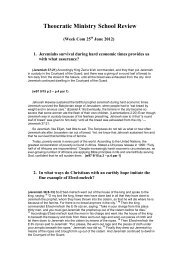1964 Awake! - Theocratic Collector.com
1964 Awake! - Theocratic Collector.com
1964 Awake! - Theocratic Collector.com
Create successful ePaper yourself
Turn your PDF publications into a flip-book with our unique Google optimized e-Paper software.
OF<br />
WHEN the German chemist<br />
Richard Willstatter was a boy,<br />
one of his closest friends, tenMyearold<br />
Sepp Schwab, cut his knee while<br />
chopping wood. Since his parents<br />
had strictly forbidden him to use<br />
the ax, young Sepp concealed his injury.<br />
However, after a few days infection<br />
set in, and by the time the<br />
condition finally came to the attention<br />
of Sepp's parents the infection<br />
had be<strong>com</strong>e serious. A doctor was<br />
called and he decided that the only<br />
way to save the boy was to amputate<br />
the leg at once. It was only<br />
after strong persuasion by the parents<br />
that the doctor agreed to postpone<br />
the operation until the following<br />
morning.<br />
That evening when they were discussing<br />
what they could do for their<br />
son, the father suddenly remembered<br />
the marvelous cures performed<br />
by a certain shepherd. Immediately<br />
the man was found. After<br />
examining Sepp, he went out into<br />
the fields and came back with a<br />
handful of plants. The Schwabs recognized<br />
some of them as the ontinary<br />
nettle, plantain and watercress.<br />
The shepherd cut all of these into<br />
very fine pieces, until they were a<br />
mass that resembled cooked spinach.<br />
This was applied to the wound.<br />
The next morning when the doctor<br />
arrived, he was surprised to find<br />
16<br />
CABBAGE<br />
that the infection was considerably<br />
improved and the fever had receded.<br />
He, therefore, was agreeable to postponing<br />
the amputation again. By<br />
this time the shepherd had brought<br />
more herbs, and this second mixture<br />
was even more successful than the<br />
first. In time the swelling disappeared<br />
entirely and the wound<br />
healed.<br />
It is reported that this healing effected<br />
by plants made an indelible<br />
impression upon young Richard<br />
Willstatter, who was watching closely<br />
the progress of his little friend.<br />
Later, Willstatter studied chemistry<br />
at Munich University and became an<br />
outstanding student of the biochemistry<br />
of plants. For his investigations<br />
into chlorophyll and the revolutionary<br />
discoveries he made,<br />
Willstatter was awarded the Nobel<br />
Prize in 1915.<br />
But despite such investigations<br />
that revealed the marvelous processes<br />
of plants, during the years that<br />
followed, the attention of medical<br />
men was directed almost exclusively<br />
toward the producing of synthetic<br />
drugs. Scientists and doctors, for the<br />
most part, had no interest in investigating<br />
the healing properties of<br />
plants. However, in view of the<br />
many remarkable cures realized by<br />
employing plants, there is certainly<br />
no good reason to hold a contemptuous<br />
attitude toward them. They<br />
have been used successfully in medicine<br />
for centuries.<br />
Successful Plant Remedies<br />
For hundreds of years Polynesians<br />
used the leaves of the papaya tree<br />
to treat their wounds. When a person<br />
was injured, his wound was<br />
bound in these leaves. Modern medi-<br />
AWAKE!




